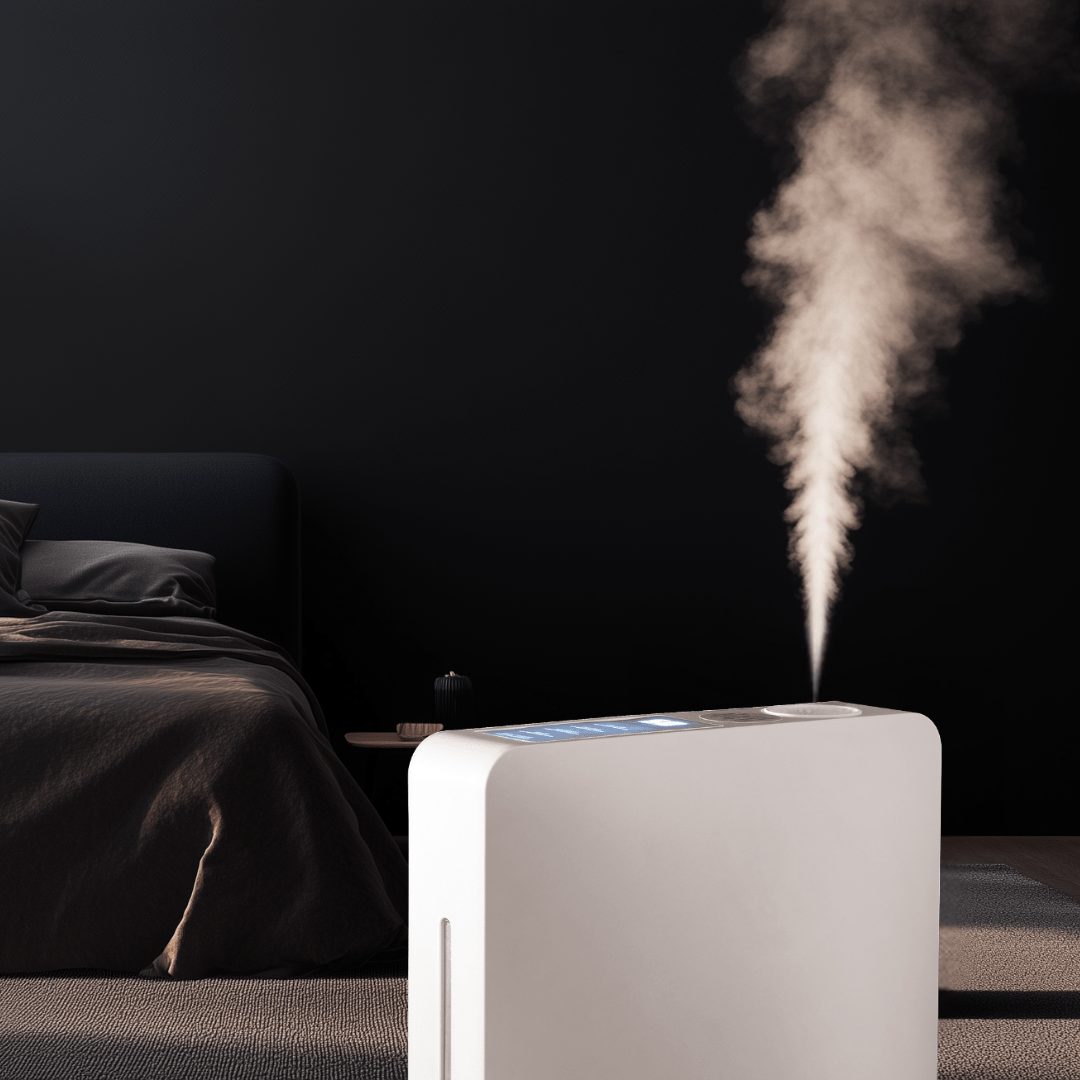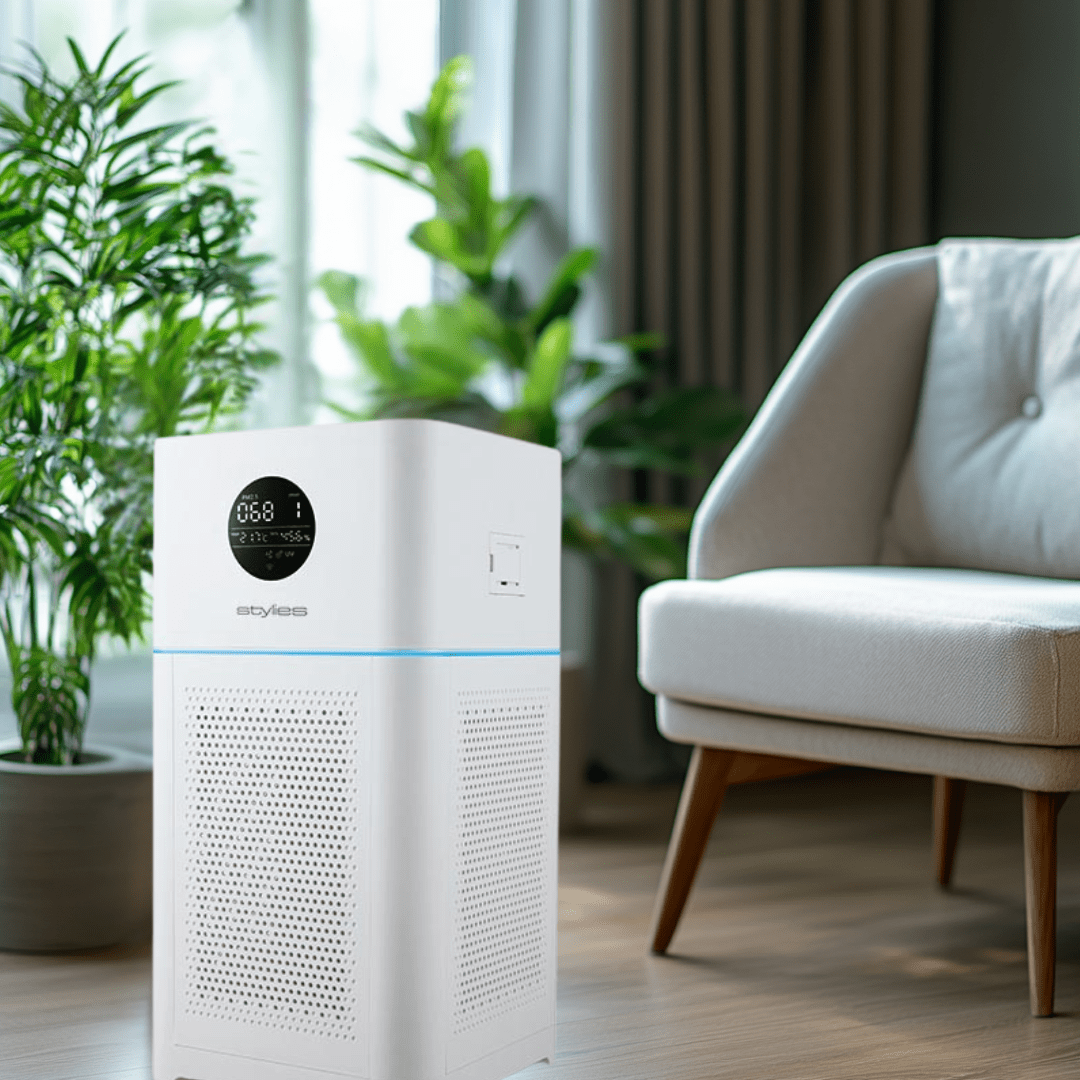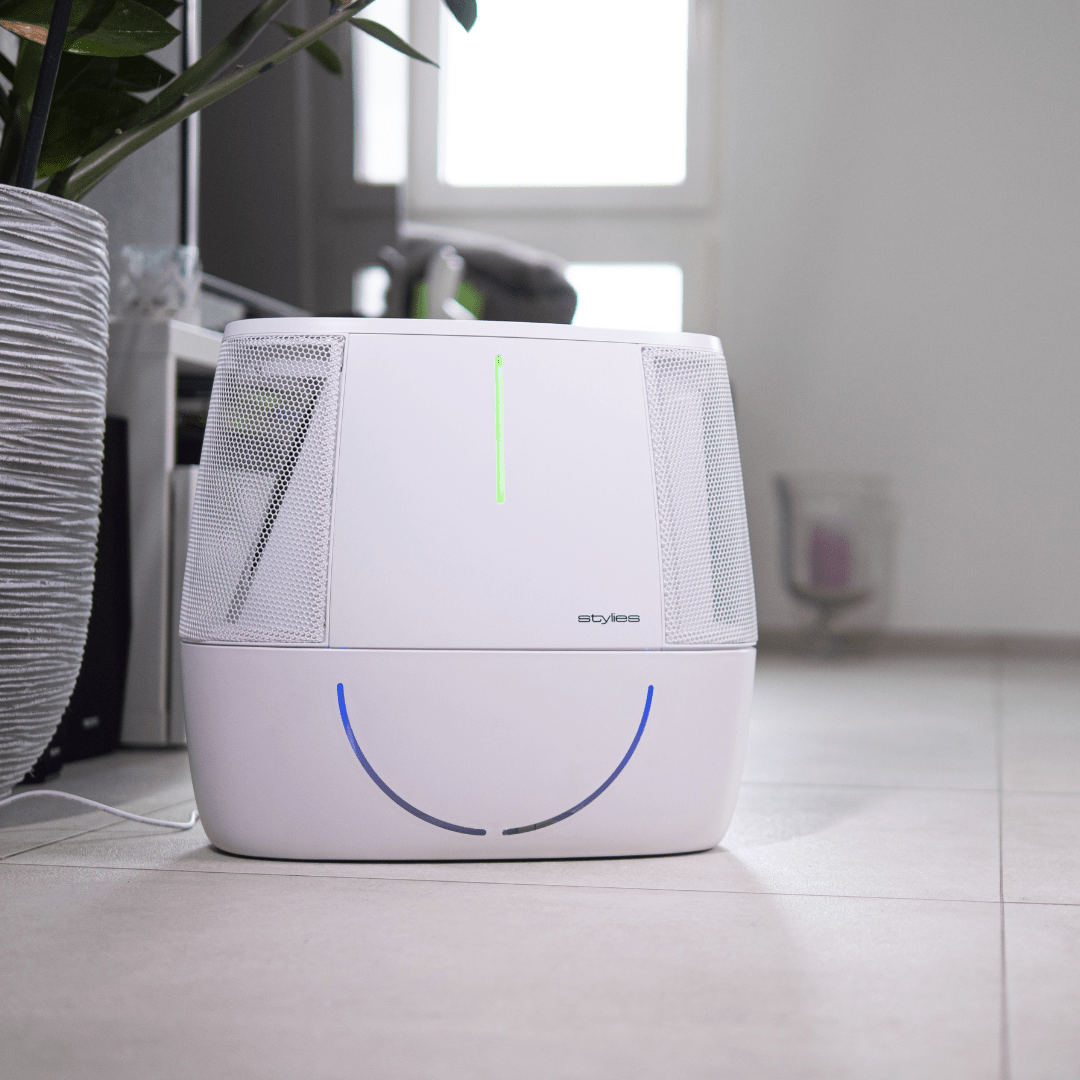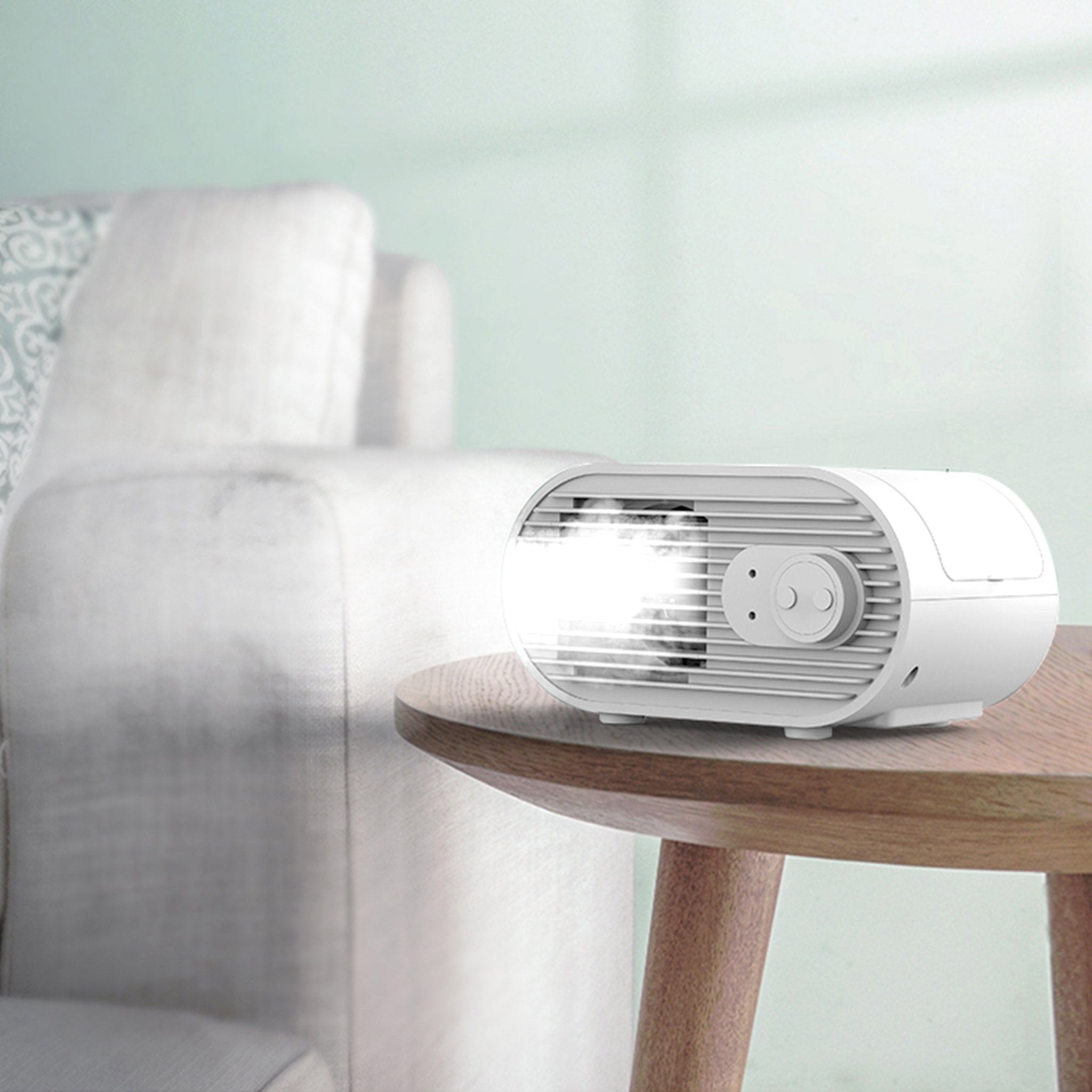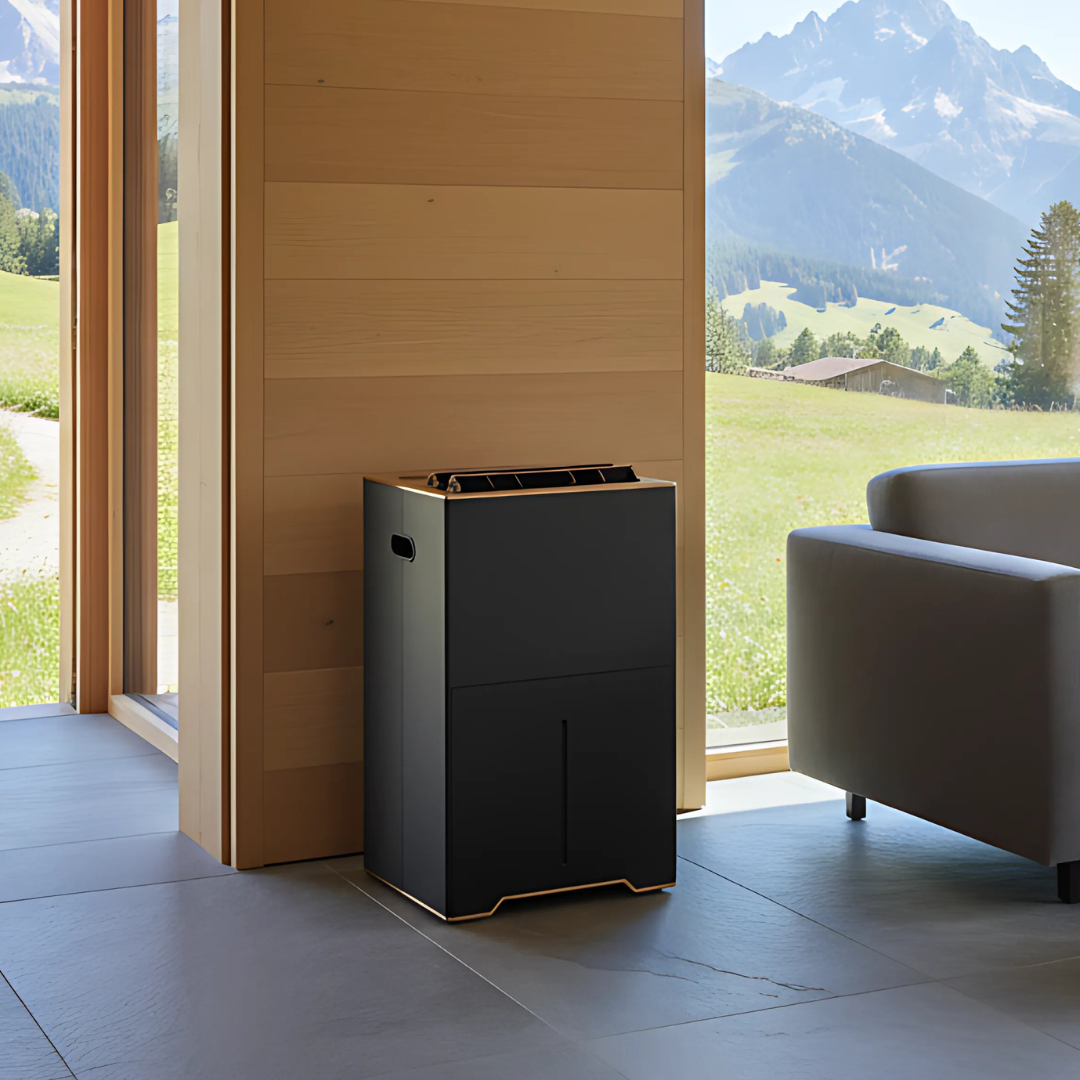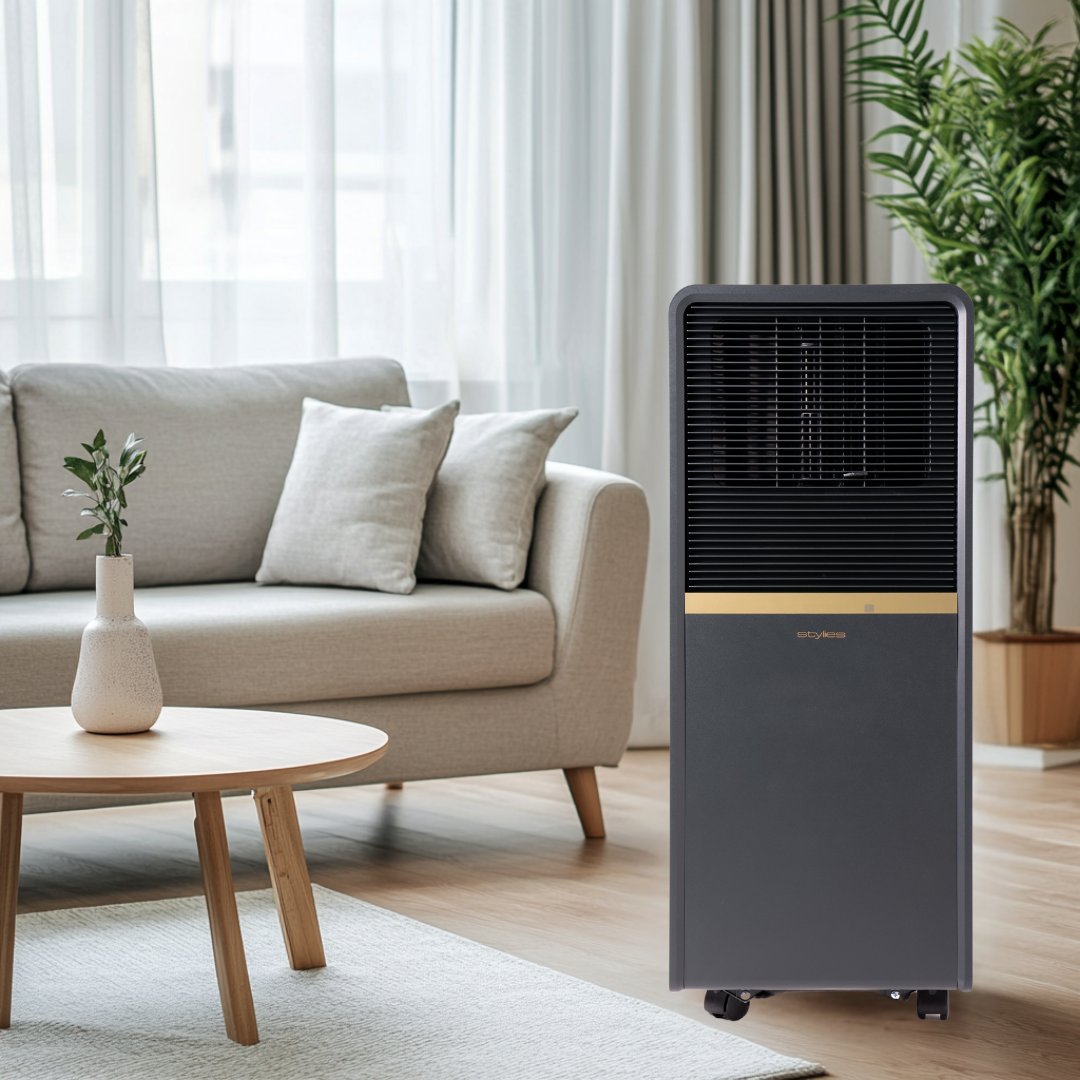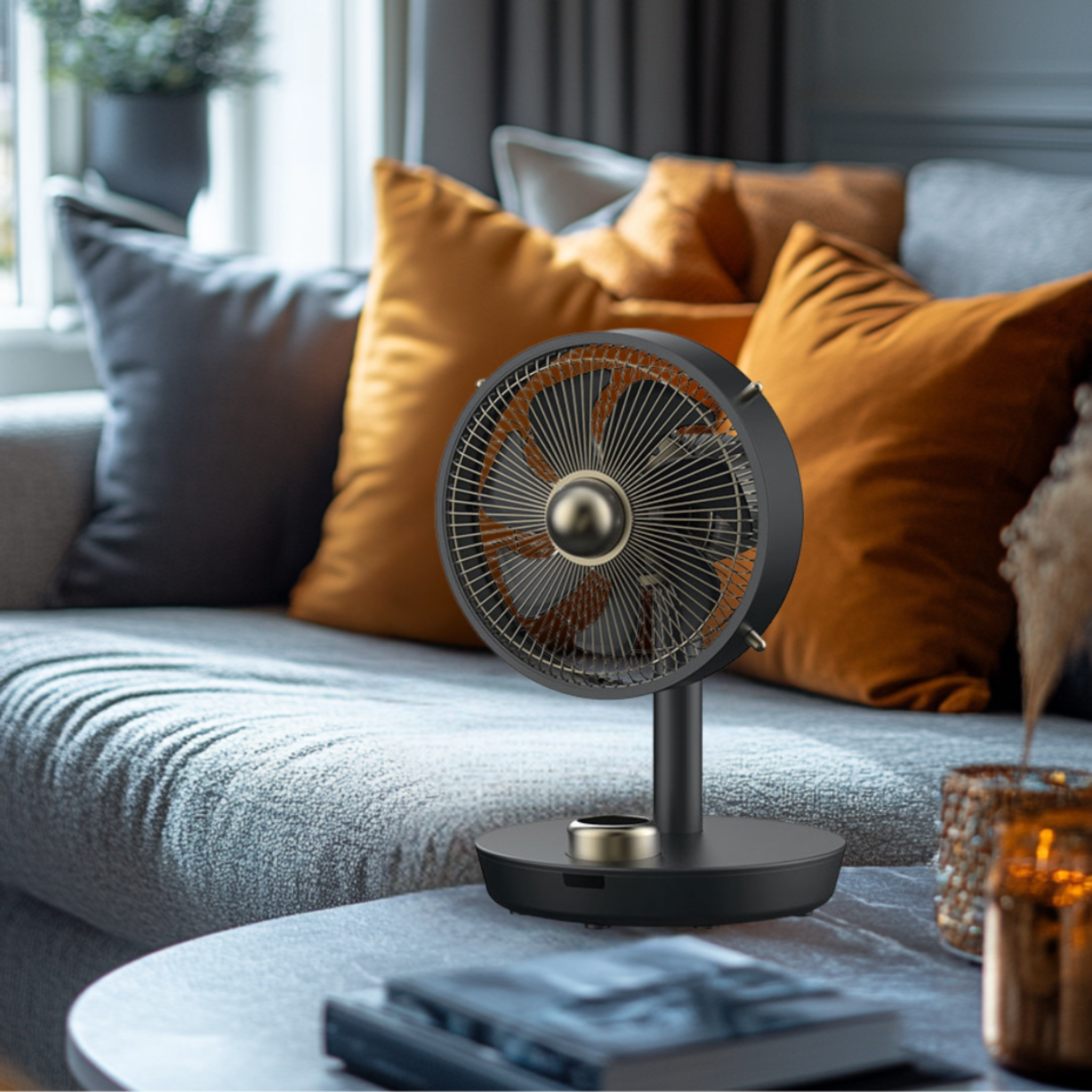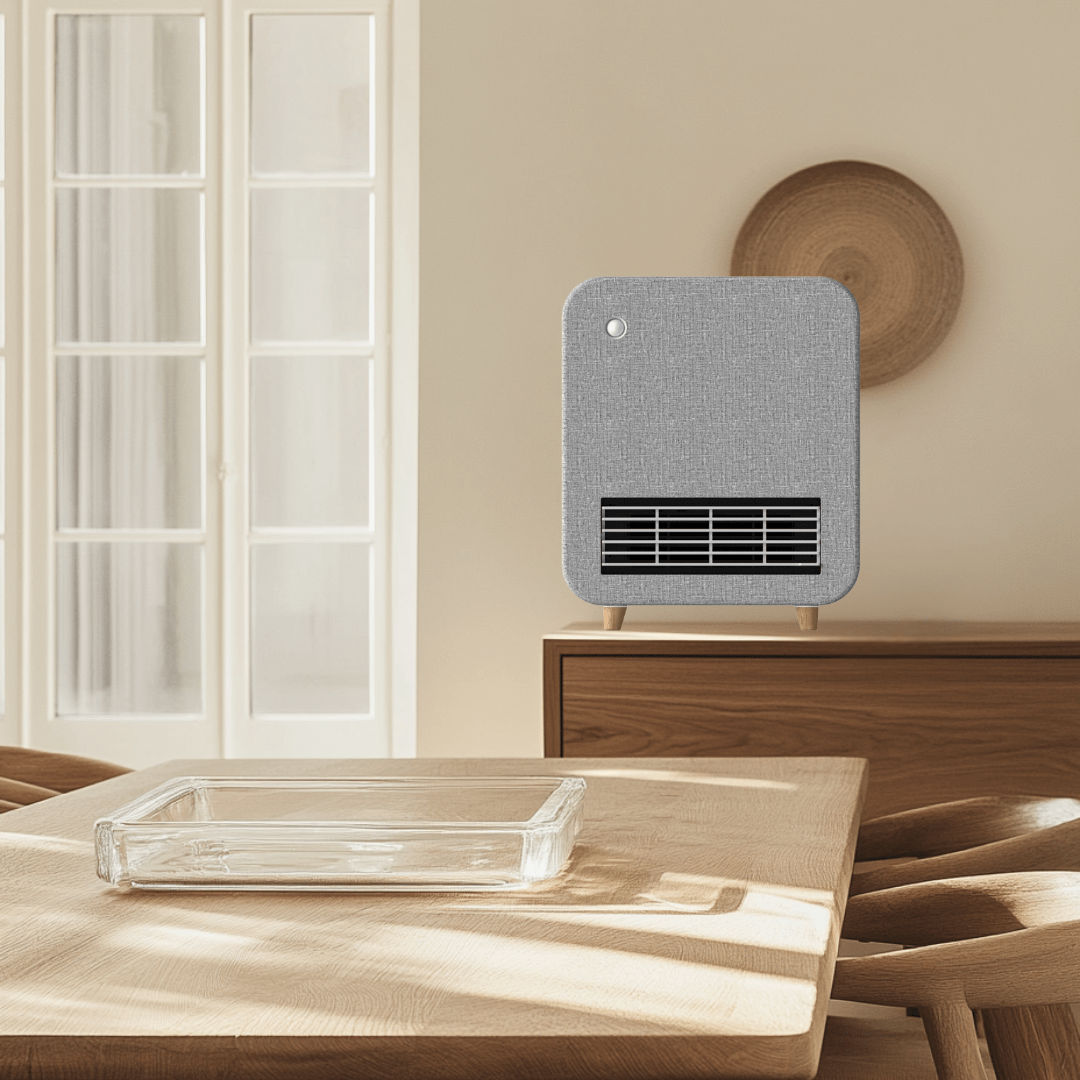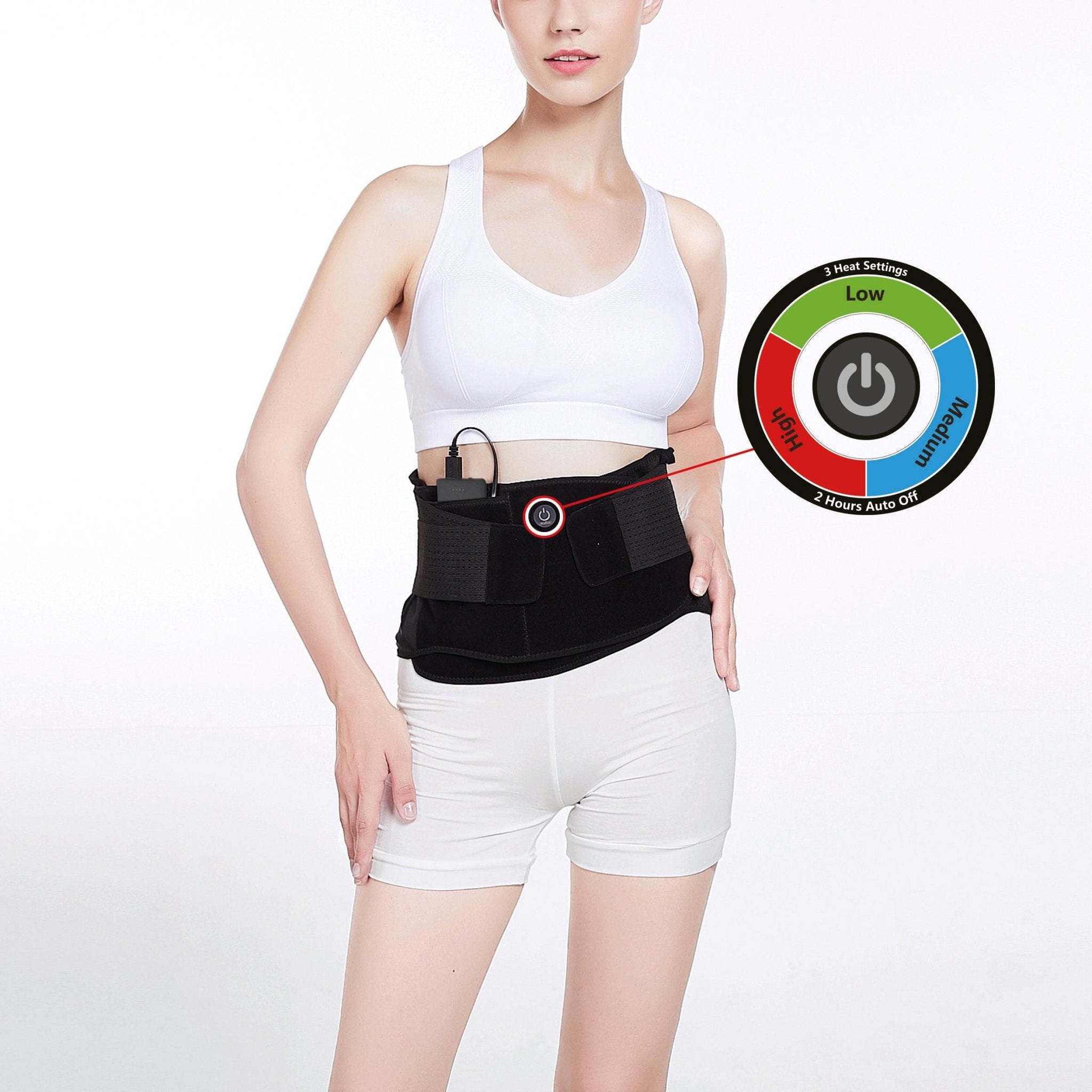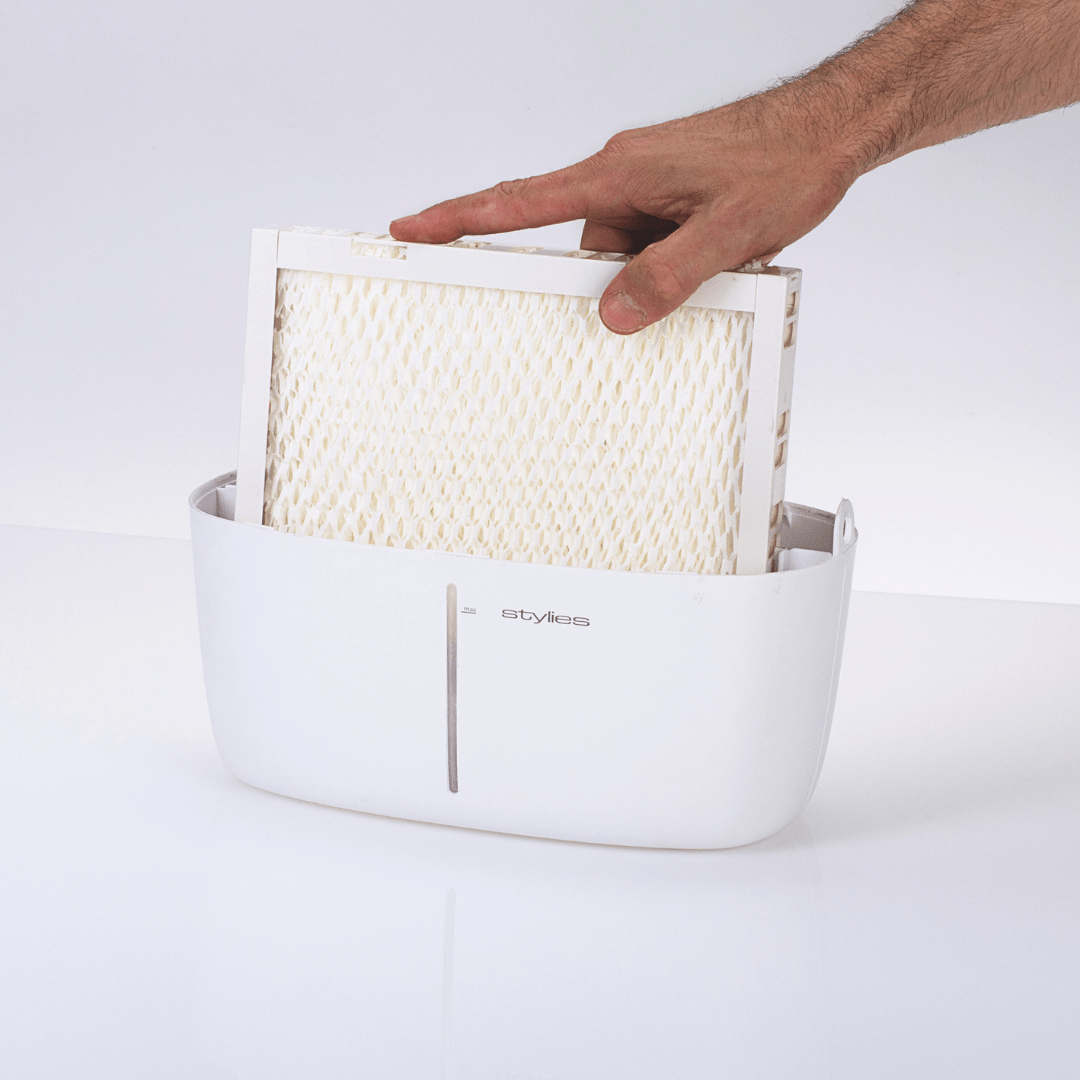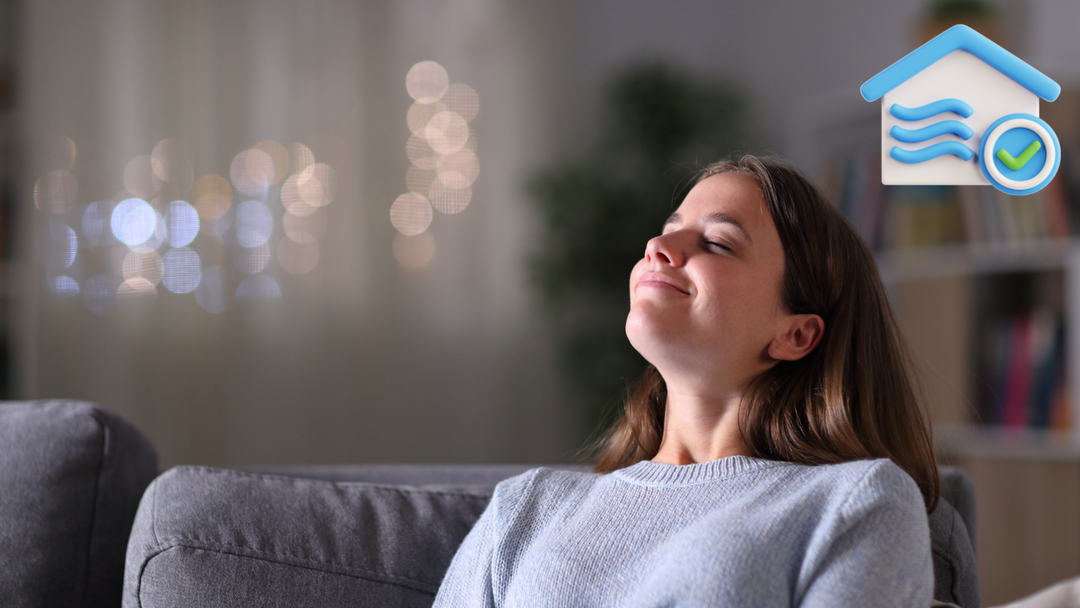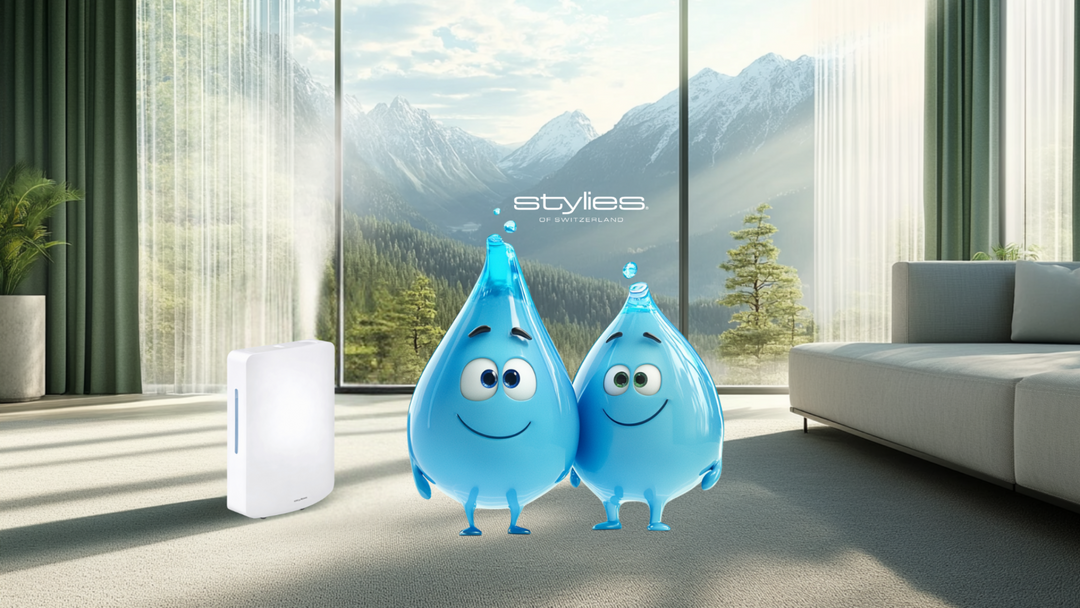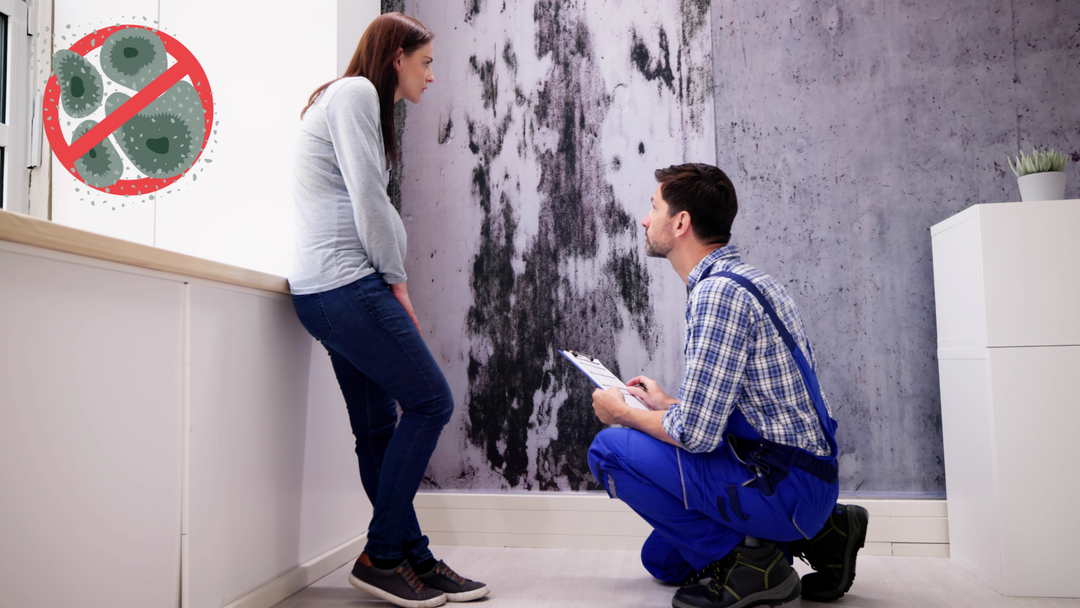Deep Dive | Indoor air purification
Deepening the topic of air quality
Importance of indoor air quality
Breathing air quality refers to how clean and healthy the air is that we breathe in enclosed spaces. Since people today spend around 85% of their time indoors , the quality of this air is crucial. Indoor air is often even more polluted than outdoor air. .
Numerous pollutants and contaminants can occur in living spaces and offices, negatively affecting the indoor climate and health. Good breathing air quality is characterized by low pollutant concentrations, sufficient oxygen, a pleasant temperature and humidity, and few odors.
In contrast, poor air quality can be recognized by stale, stuffy air (high CO₂ content), odors, increased particulate matter pollution or noticeable humidity.
By ventilating away the carbon dioxide exhaled by humans, other air pollutants such as volatile organic compounds ( VOCs - stands for Volatile Organic Compounds, in German volatile organic compounds that easily evaporate and enter the air even at low temperatures) from furniture, carpets or wallpaper are automatically reduced.
The CO₂ content in the air is measured in ppm ( parts per million)
Typical pollutants and contamination in living spaces and offices
Indoors, a “cocktail of pollutants” often arises from various sources The most important pollutants and stress factors are:
-
Carbon dioxide (CO₂): Produced primarily through human respiration. Elevated CO₂ levels (over approximately 1,000 ppm - parts per million ) lead to fatigue, poor concentration, and malaise. Very high levels (>1,500 ppm) are considered unacceptable and require urgent ventilation. CO₂ is an indicator of stale air and inadequate ventilation, especially in meeting rooms, classrooms, or bedrooms with closed windows.
-
Fine dust (particles, PM2.5/PM10): Tiny suspended particles in the air that enter from outside (e.g., urban traffic, industry) or originate indoors. Indoor sources include smoking, cooking, baking, candles, or fireplaces – these can significantly increase particulate matter pollution. Laser printers and copiers in offices also release ultrafine particles. Fine dust penetrates deep into the lungs; in the long term, it increases the risk of respiratory and cardiovascular diseases. According to studies, up to 75% of fine dust particles in many homes come from outside , but indoor sources predominate in households where smoking or cooking takes place. .
-
Volatile organic compounds (VOCs): This is a group of gaseous chemicals (e.g., solvents, benzene, terpenes) that are released from paints, varnishes, adhesives, furniture, carpets, or cleaning products. A well-known VOC is formaldehyde , which is released from particleboard furniture, varnishes, or tobacco smoke. VOCs can cause irritating odors, headaches, respiratory irritation, and even nervous system impairment, and some (like formaldehyde) are considered carcinogenic. New furniture or newly renovated rooms often have elevated VOC levels (known as the “new build smell”).
-
Microorganisms and allergens: Bacteria and viruses can float in the air, especially in poorly ventilated rooms with large numbers of people (cold and flu viruses, SARS-CoV-2, etc.). Mold spores from damp walls or air conditioning/humidifiers also pollute the air. House dust mites (or their allergenic droppings) and pet hair/dander are other allergens in house dust. Pollen from outside can enter through windows. These biological particles trigger sneezing, eye irritation, asthma, and other allergic reactions in allergy sufferers.
-
Harmful gases from combustion and technology: Nitrogen dioxide (NO₂) is produced by combustion in gas stoves, ovens or by car exhaust fumes that come in from outside Carbon monoxide (CO) can occur in defective gas boilers or furnaces – it is odorless and highly dangerous (risk of poisoning). Ozone (O₃) can enter from outside on hot summer days or be produced indoors by electrical devices (old laser printers, copiers) and so-called "ionizers." Ozone is an irritant gas that causes inflammation in the lungs and is rejected by the Federal Environment Agency as harmful to health in residential areas. .
-
Odors and smoking: Indoor tobacco smoke is a major source of pollutants: it contains particulate matter, VOCs (e.g., benzene, formaldehyde), CO, nicotine, and other toxins. Secondhand smoke drastically degrades indoor air quality and increases health risks. While air fresheners, perfumes, and essential oils mask odors, they can themselves release VOCs and create new irritants. .
This makes it harder for the body to eliminate inhaled dust particles, bacteria, and viruses . Polluted air can be a real problem, especially for allergy sufferers, asthmatics, or people with other lung diseases .
Control sources: The pollutants mentioned come from everyday sources. In living spaces, for example , cigarette smoke, gas stoves, cleaning products, perfumes/fragrance sprays, and emissions from building materials and furniture significantly affect the air we breathe. .
In offices, crowds of people, office equipment (printers, copiers), and carpeting are additional sources. The more emission sources in the room, the more a pollutant cocktail can accumulate. It's therefore important to consider low-emission materials during construction and furnishing. Use low-emission products wherever possible and avoid unnecessary chemicals in the home (e.g., air fresheners or aggressive cleaners).
Health effects of poor indoor air
Poor indoor air quality has a direct impact on our health .
In the short term, headaches, fatigue and concentration problems can occur in the eyes, nose and throat if the air is “bad” (e.g. due to high CO₂ levels or solvent vapors).
In sensitive individuals and allergy sufferers , pollen, dust, or mold spores can cause allergic reactions and even asthma attacks. Dry air (low humidity) irritates mucous membranes and promotes infections, while very humid air promotes mold growth.
In the long term, constant inhalation of pollutants increases the risk of chronic diseases. For example, fine dust can promote the development of asthma, bronchitis, and cardiovascular disease; formaldehyde is suspected of causing cancer; and mold infestation in homes has been linked to respiratory diseases. .
Cognitive performance should not be neglected either: even moderate CO₂ concentrations of ~1,500 ppm can cause headaches, drowsiness and reduced mental performance In offices and schools, poor air quality has been proven to negatively impact concentration and productivity. Stagnant, unventilated air also increases the risk of viral infection : If there is a lot of exhaled CO₂ in the air, the aerosol concentration (which can carry viruses) is also high. Good ventilation and air purification also reduce the risk of droplet infections (e.g., COVID-19, influenza).
Particularly vulnerable groups include children, the elderly, asthmatics, and allergy sufferers. Children breathe relatively more air (relative to their body weight), and their development can be more severely affected by pollutants. Allergy sufferers and asthmatics often react with symptoms even to small amounts of pollutants or allergens.
Sustainability, energy consumption and design aspects
Sustainability and energy play an ambivalent role in breathing air quality: On the one hand, modern energy-saving houses require a nearly airtight building envelope, which saves heating energy – on the other hand , a tight building envelope without sufficient ventilation worsens the indoor climate .
In well-insulated new buildings, the risk of mold growth increases if ventilation is not carried out correctly. Old buildings, on the other hand, often “breathe” more due to leaky windows/joints – although moisture escapes more quickly here, heat is also lost.
The challenge lies in balancing energy efficiency and air quality . Solutions include ventilation systems with heat recovery , which supply fresh air without dissipating too much heat, or the deliberate use of air quality sensors to ventilate as needed (not leaving windows open all the time, but only ventilating briefly when needed).
When it comes to technical air purifiers and sensors, you should consider the power consumption .
Air purifiers require sufficiently powerful fans to move a lot of air—a higher airflow rate (CADR) usually also means higher power consumption. Some powerful devices draw 50–70 W or more at maximum power. That may not sound like much, but in 24/7 operation, that can add up to over 400 kWh per year. Therefore, the consumption should be checked before purchasing.
We manufacturers often specify the value at the lowest level; in reality, it is correspondingly higher when using higher levels .
Positive : Many modern air purifiers have automatic modes (controlled by built-in sensors) that only switch up when needed and otherwise run in a power-saving manner.
Even standby consumption is low with quality appliances (<1 W). Overall, improving air quality requires energy, but good appliances use it efficiently. Furthermore, clean air can help prevent subsequent costs due to health problems – an investment in quality of life.
Design aspects encompass both device design and integration into the interior design. Modern air purifiers and sensors are often designed to be visually appealing and suitable for living spaces.
There are sleek, tower-shaped purifiers that also serve as fans, or compact cubes with a discreet appearance. Good design also means quiet operation (important for bedrooms), easy operation and maintenance (filter changes), and sensible placement in the room.
An air purifier should be located as centrally as possible or close to the main source of pollution to achieve effective cleaning. Some devices can be hung on the wall or placed discreetly on a shelf.
Smart functions are also part of the design: for example, LED color ring displays (green/yellow/red) for air quality, touch panels or app control, which are embedded in the usage concept.
Last but not least, acoustics also play a role – for example, there are special night modes with dimmed displays and minimum fan speed so that the device does not disturb your sleep .
In short: Sustainability, energy, and design must be considered to ensure that air quality solutions are practical and acceptable to users. These aspects are precisely what Stylies considers in the development of its devices .
Solutions to improve breathing air quality
A holistic strategy for good indoor air comprises four pillars:
- Measuring (monitoring of air quality),
- Limit sources of pollutants
- Ventilate (supply fresh air)
- and purify the air .
Here, we focus on two technical solutions: air purifiers and air quality sensors . (Note: Traditional ventilation is still essential—this will be discussed in the tips at the end.)
Air purifier: filter against pollutants
Air purifiers are portable devices that draw in room air, filter out impurities, and expel the purified air. They can remove fine dust, pollen, pet dander, bacteria, viruses, and sometimes even gaseous pollutants. .
The most common systems are fan-assisted filter units . They usually consist of a pre-filter, a HEPA filter , and often an activated carbon filter :
-
A HEPA filter (High Efficiency Particulate Air) consists of a fine fiber mesh that filters out ≥ 99.95% of all particles from ~0.1–0.3 µm (H13 class) . It can therefore separate fine dust, smoke particles, pollen, spores and even many viruses and bacteria For virus protection, HEPA H13 or H14 are recommended as they effectively capture even very small aerosols .
-
An activated carbon filter consists of highly porous carbon and adsorbs gaseous pollutants such as VOCs, ozone, or odors. It complements the particulate filter and removes chemicals and unpleasant odors (e.g., from cooking or smoking). Activated carbon is important for reducing formaldehyde and other VOCs .
-
The pre-filter (usually a coarse grid/net) catches coarse dust, fluff or animal hair to protect the expensive fine filters.
How it works: A fan draws the air through this filter cascade and blows it out as purified air The result is noticeably clean indoor air – air purifiers often promise to remove 99% of pollutants from the air .
In practice, efficiency depends on the filter system and air flow rate . Good devices achieve high CADR (Clean Air Delivery Rate, in m³/h) values , meaning they can circulate and filter a room's air several times per hour. When properly dimensioned, fine dust, pollen, and other contaminants are significantly reduced. Studies during the coronavirus pandemic, for example, showed that HEPA air purifiers significantly reduced aerosol concentrations and thus the risk of infection in classrooms.
Other technologies: In addition to HEPA filters, there are alternative cleaning methods . Some devices use electrostatic filters or ionizers : These electrically charge particles, causing them to stick to panels or simply to the walls/floor. Ionizers operate filter-free and quietly and can also inactivate germs. Their effectiveness against particles is limited because the dust falls from the air but remains in the room (and must be wiped away later).
Some air purifiers incorporate UV-C lamps to kill bacteria and viruses. While high-energy UV-C can kill germs, it poses risks: If the radiation escapes, it could be harmful to skin and eyes. . Therefore, UV devices are only available from well-known manufacturers who take technology and application into account in the development of the devices.
Areas of application: Air purifiers are useful wherever air pollutants occur or ventilation is inadequate . Typical applications include:
-
For allergy sufferers: Filter devices can significantly reduce pollen, house dust, and pet allergens. In the spring, when hay fever strikes , a purifier in the bedroom or living room can make breathing easier—especially when airing out is difficult due to high pollen levels outside. Pet owners with allergies also benefit from HEPA filters, which remove pet hair and dander from the air. .
-
Fine dust and urban air: In cities with high levels of fine dust (or near busy roads), a purifier helps to capture outside air particles, especially when you ventilate in the evening and fine dust flows in.
-
Smoke and odors: In households with smokers (or if, for example, a laser printer is used extensively in a home office), a device with an activated carbon filter can reduce smoke particles and odors. However, nothing replaces completely refraining from smoking indoors – a purifier cannot completely eliminate tar, carbon monoxide, etc. In the kitchen, an air purifier with an odor filter can eliminate cooking odors or fumes more quickly (although a range hood positioned directly at the source is more effective).
-
Poorly ventilated rooms: In small or windowless rooms (e.g., interior offices, archives, basements) or in heavily insulated rooms where ventilation is limited in winter for fear of heat loss, a purifier can support air quality. Especially where window ventilation is insufficient , mobile air filtration devices can help maintain a healthy indoor climate. – they do not replace the oxygen from outside, but at least filter out pollutants.
Effect, advantages and disadvantages: A suitable device – correctly dimensioned for the room size – can actively improve the indoor climate.
However, there are large differences in function and effectiveness :
-
One advantage is the immediate effect : if you switch on a powerful cleaner in a contaminated room, particle readings, for example, often drop significantly within minutes.
-
Flexibility: Mobile air purifiers can be set up as needed and can also be taken with you (e.g. in the living room during the day, in the bedroom at night).
-
Medical benefits: For allergy sufferers and those with chronic lung disease (asthma, COPD), an air purifier can provide noticeable relief. Studies in nursing homes also show that air filters can reduce viral load and prevent infections In times of pandemics/flu waves, they serve as an additional protective measure against aerosol-borne diseases.
-
Ease of use: Many devices operate fully automatically with sensors , have timers, remote controls/apps, and filter change indicators. These extras increase convenience.
There are also disadvantages :
-
Noise: A fan always makes noise. At its highest setting, fans can reach ~60–70 dB (comparable to conversation volume). . For bedroom use, you must therefore switch to low, quiet settings or a particularly quiet model. A loud fan can also be annoying during the day in the office.
-
Energy consumption: As explained above, air purifiers consume electricity – a high air flow requires power. In the worst case scenario (continuous operation at maximum power), significant electricity costs can arise. However, this can be optimized with automation and needs-based use.
-
Maintenance costs: Filters must be changed regularly , typically every 6–12 months (depending on contamination) Replacement filters are not cheap. If you neglect to change them, they will clog and the cleaning performance will drop dramatically. .
-
No CO₂ removal: Important: No standard air purifier filters CO₂. Carbon dioxide is a non-toxic gas that is barely absorbed by activated carbon and passes unfiltered through HEPA. This means that even the best filtration system cannot replace ventilation! A room can be chemically "clean" and dust-free, but still be stuffy with a high CO₂ content. You will then feel tired, despite the air purifier. Therefore: Ventilation remains essential to exchange stale, humid, CO₂-rich air for oxygen-rich fresh air. .
-
Limited range: Each mobile cleaner can only effectively cover a certain room size . Manufacturers usually specify a maximum square footage (often around 20–50 m²). In larger rooms or open floor plans, a single device may be insufficient, or several may be needed. Walls also block air circulation, so a separate device is usually required for each room.
-
By-products: Doubtful technologies (ionizer, UV, ozone) can produce unwanted by-products such as ozone . Therefore, it is recommended to rely on proven HEPA/carbon filter technology and to choose devices with the appropriate test seals.
Air quality sensors: Measure to improve
Air quality sensors or monitors are devices that monitor important indoor air parameters. While they don't purify the air themselves, they provide data that can be used to control ventilation or cleaning measures. Following the motto "measure what you breathe," they help make invisible problems visible.
Typical sensor types are:
-
CO₂ sensors: These measure carbon dioxide levels in ppm and are a direct indicator of fresh air requirements. They are usually based on NDIR infrared sensors that detect CO₂ via light absorption. Recommended CO₂ levels are below 1,000 ppm , ideally below 800 ppm. Many CO₂ measuring devices use a traffic light display : green (good air <800), yellow (moderate ~800–1,400) and red (poor >1,400 ppm) Some emit an acoustic alarm when a threshold value (~1,500 ppm) is exceeded – then it's time to "open the window!" . Especially in offices, classrooms or conference rooms with many people, CO₂ traffic lights are now widespread to ventilate in a timely manner and thus improve performance and virus protection. A CO₂ sensor also helps in the living area (e.g., in the bedroom) to see if the levels rise overnight and whether you need to ventilate in the morning.
-
Fine dust/particle sensors: These devices typically use laser scattering to determine the concentration of PM2.5 (fine dust <2.5 µm) and often also PM10 . They indicate when particle levels are rising, for example, due to cooking, candles, or external air supply. A particle sensor can indicate, for example, that a lot of dust was stirred up while vacuuming or that ventilation is not advisable at the moment because the outside air is polluted. Knowing PM levels can also be helpful for people with fine dust allergies (if they exist) or asthmatics. Modern combination sensors often indicate whether the fine dust pollution is within the healthy range (the WHO recommends <15 µg/m³ daily average for PM2.5). Stylies air purifiers have integrated PM sensors that automatically increase the fan speed when fine dust is detected.
-
VOC/gas sensors: These are usually semiconductor sensors (MOS) that are sensitive to volatile organic compounds . They often provide a VOC index or "air quality index" that nonspecifically reports high gas concentrations (e.g., from solvents, cooking, fragrances). A VOC sensor will react, for example, when solvents from new paint are off-gassing or when many people are breathing in the room (people also emit VOCs and odorants), but it cannot differentiate between individual gases. Such sensors are useful for assessing odor pollution or general air cleanliness. Some monitors also have formaldehyde sensors (for sensitive measurements in contaminated new buildings), but these are more expensive and less common.
-
Climate sensors: Almost all air quality monitors also measure temperature and relative humidity, as these parameters are also important for well-being and health. Optimal humidity is between 40–60%; values above this promote mold and mites, and air that is too dry (<30%) irritates the respiratory tract.
Areas of application: Sensors are particularly useful where you want to make the invisible visible :
-
In offices, schools, public spaces : CO₂ measuring devices are now standard recommendation to ensure sufficient ventilation and maintain people's well-being and performance Especially in times of Corona, CO₂ traffic lights have received a lot of attention because they indirectly indicate when aerosol accumulations (and thus potentially viruses) are high. .
-
In the Smart Home : Private users use air quality sensors to monitor the climate in the bedroom or children's room (temperature, humidity, CO₂ – important for sleep quality). A sensor can also help in the home office to ventilate in time before you get tired. .
-
Building management: In modern, energy-efficient homes, sensors can be part of the ventilation system – for example, CO₂ or humidity sensors control automatic window ventilation or ventilation systems so that fresh air is always supplied as needed.
-
Pollutant monitoring: Those living in an area with radon levels may want to use a radon sensor in their basement. Or, after a renovation, a VOC/formaldehyde monitor can indicate when the fumes subside. Allergy sufferers could use a PM sensor to check how much pollen, for example, is getting into their home.
Advantages: The primary effect of sensors is to enable appropriate action. Advantages:
-
Awareness: A monitor creates transparency. For example, you notice that the air quality is poor after a two-hour meeting—this triggers the need to ventilate. Without a sensor, poor air quality is often not noticed until you're already feeling unwell.
-
Optimization: Measurements can help you improve ventilation habits. For example, you might learn that short bursts of ventilation are very effective, while keeping windows tilted are less effective. Or you might notice that CO₂ levels rise quickly in the evening and schedule additional ventilation before bedtime.
-
Energy saving: Paradoxically, sensors also help save energy: Instead of constantly leaving a window open "just in case" (which results in loss of heating energy), you can rely on the sensor and only ventilate when necessary. This creates demand-based ventilation – good for both the air and the heating system.
-
Control of devices: In smart homes, sensor values can automatically control air purifiers or fans —for example, the air purifier switches on as soon as fine dust is detected, or a window actuator opens at 1,000 ppm CO₂. This allows air pollution control to operate partially autonomously.
-
Long-term data: Some monitors store historical data. This allows you to identify patterns (e.g., a daily high CO₂ peak in the bedroom in the morning) and adjust your home/mobility if necessary (perhaps leaving the door open in the evening, etc.). Historical data is also helpful for assessing the effectiveness of measures (new cleaner, different ventilation).
The limitations/disadvantages of sensors:
-
No direct improvement: Sensors don't eliminate pollutants, they only indicate them. Therefore, users have to actively respond (or pair devices). Without follow-up measures, even the most attractive display is of little use.
-
Calibration and accuracy: Cheap consumer sensors are sometimes inaccurate or provide estimates. For example, VOC sensors often have nonspecific indices that are difficult to interpret ("VOC Index 200" – what exactly does that mean?). CO₂ sensors occasionally need to be calibrated in fresh air. With cheap particulate matter sensors, measurements in clean air near zero can be difficult. Therefore, one should not rely on absolute values down to the nearest part per thousand, but rather observe trends . However, they are usually sufficiently accurate for home use (CO₂ ±50 ppm in typical ranges). .
-
Cost and effort: A good monitor with multiple sensors is expensive to purchase. If you want to cover every floor or multiple rooms, it becomes correspondingly more expensive. Additionally, some require a power supply (AC adapter) and a Wi-Fi/Bluetooth connection for the app. Battery-operated models have a limited battery life, but thanks to the E-Ink display, they can last for several years on a single charge . You also have to remember to change the batteries or recalibrate the devices from time to time.
-
Data protection and cloud: Some smart monitors send data to a cloud/app. Security-conscious users should be careful about where the data is stored. However, there are also devices with a local display that can be used offline.
Examples of air purifiers and air quality measuring devices
For illustration purposes, the following table lists some example products – both air purifiers of various types and air quality sensors – with their key features:
Special requirements in different living and usage situations
Allergy-friendly measures
Indoor air quality is particularly important for allergy sufferers (pollen, dust mite, and pet allergies). Even small amounts of allergens can trigger symptoms. The following measures help keep allergen exposure low indoors:
-
Use HEPA air purifiers: As described above, devices with HEPA 13/14 filters filter up to 99.97% of the finest allergens from the air A suitable air purifier in the living room or bedroom can, for example, keep the indoor air largely pollen-free during the pollen season and thus alleviate allergy symptoms. Important: Adjust the unit to the room size and run continuously if possible to ensure that newly arriving allergens are immediately captured. Models with an "allergy mode" are particularly practical; they react immediately to the smallest particles and increase fan performance.
-
Reduce soft furnishings and dust traps: In living spaces with people who are allergic to house dust, the fewer dust traps, the better. Carpets, heavy curtains, and open shelves full of books collect a lot of dust and mites. Smooth floors (parquet, vinyl) are easier to dust. If carpets are desired, choose short-pile ones and clean them regularly. (Interestingly, some studies show that permanently laid carpets can bind fine dust and halve the particulate matter in the air compared to smooth floors—but only if the carpet is kept clean.) ) For allergy sufferers, washable curtains, bed linen and cuddly toys are important – washing at ≥60 °C kills mites.
-
Bed and mites: People with dust allergies should use encasings for their mattress, duvet, and pillows (mite-proof covers) to prevent mite droppings from getting into the air they breathe. A dry room climate (<50% humidity) also helps, as mites love high humidity. Ventilate the bedroom well in the morning to remove nighttime moisture. Vacuum at least once or twice a week, ideally with a HEPA filter in the vacuum cleaner to prevent the vacuum from blowing out fine dust.
-
Keep pollen out: During pollen season, ventilate thoroughly at times when pollen levels are low (often late at night or after rain). Keep windows closed during the day or install pollen screens – these are tight-meshed gauze nets that trap at least some of the pollen. Don't take off clothes that were worn outside (and are laden with pollen) and leave them in the bedroom. Shower at night to remove pollen from your hair.
-
Pets: People with pet allergies should keep their bedrooms free of pets. Regular brushing of the pet (outdoors) and frequent water changes in the aquarium (for mold allergies) can help. Air purifiers can reduce pet allergens in the air (dander, saliva droplets), but they are no substitute for basic cleaning.
Children's room and bedroom
Special requirements apply to children's rooms and bedrooms , as sensitive individuals rest and spend a lot of time there (overnight). Important points:
-
Quiet, emission-free devices: If air purifiers or humidifiers are placed in the bedroom, they must be very quiet (night mode, <30 dB) and must not have any distracting lights – ideally, they should have dimmable or switchable displays. Many purifiers have a sleep mode with a dimmed display and whisper-quiet operation. If the device is still bothersome, it's better to leave it running during the day and turn it off or at the minimum setting when sleeping. Ionizers or ozone-generating devices are taboo in bedrooms, as ozone would irritate mucous membranes, especially during sleep. Therefore, only use filter devices without harmful byproducts.
-
CO₂ in the bedroom: CO₂ builds up significantly overnight in a closed bedroom, which can lead to morning fatigue. Ventilation is particularly important when several people (or people + pets) sleep in the room. A CO₂ sensor in the bedroom can indicate whether the room should be ventilated at night or early in the morning – or whether the door to the hallway should be left ajar to allow some air exchange. Parents should pay particular attention to ensuring there is enough fresh air in the children's room, as otherwise children will sleep restlessly. Tip: Ventilate thoroughly before going to bed (shock ventilation) to start the night with low CO₂ and higher oxygen levels; if the windows are very airtight, consider leaving them ajar if outside noise allows.
-
Temperature and humidity: Bedrooms should be cool (ideally around 18°C) and not too humid. However, excessively dry air in winter can dry out mucous membranes. A humidifier may help here, but be careful: clean regularly to prevent germs and keep humidity levels below 50%, otherwise there's a risk of mold. Alternatively, use a bowl of water or wet towels (but be aware of the risk of mold here, too). In children's rooms, mechanical humidifiers (evaporators/vaporizers) are preferable to electric ones, as the latter often spread bacteria if not properly maintained.
-
No harmful substances in the children's room: It's especially important to avoid off-gassing when it comes to children. Wall paints, furniture, carpets, etc. should be low in harmful substances. Be sure to air out new furniture thoroughly (perhaps set it up in an empty room initially, with the window tilted open for several days). Plastic toys can emit fumes from plasticizers—pay attention to quality. No smoking , of course, and heavily perfumed cleaners or air fresheners are also out of place in children's rooms.
-
Filters to combat "baby smell"? Some parents place air purifiers in the baby's room to combat odors (e.g., dirty diapers). An activated carbon filter can reduce odors somewhat, but regular ventilation and using the diaper pail are more important. Generally, air purifiers don't harm babies, as long as they operate quietly and without ozone – but they're only necessary if there's a specific problem (e.g., a smoking household or allergies).
-
Safety: Devices in children's rooms should be positioned so that they cannot tip over (not on wobbly bases) and, if possible, have no small parts accessible. Keep cables away (there is a tripping or playing hazard). Some air purifiers have a child-safe mode (locking the buttons). A battery-operated (cordless) CO₂ monitor may be better for children than a mains-powered device.
In short: Rest-friendly operation is paramount in the sleeping area. Fresh air is essential – technology can support this (quiet air purifiers, sensors for reminders), but undisturbed sleep takes precedence over optimal ventilation technology. It's better to ventilate and clean well during the day to ensure peace and quiet at night.
Old building vs. new building:
Differences and challenges
Old buildings and new buildings can have very different air quality problems:
-
Old buildings (unrenovated older buildings): Many old buildings have leaky window frames and cracks – so there is a certain amount of natural air exchange (infiltration). This can mean that CO₂ and humidity never reach extremely high levels because a constant flow of fresh air is provided. However, these same leaks can also allow outside air pollution to penetrate unfiltered (fine dust from the street, noise, cold). Furthermore, old buildings are more frequently affected by moisture problems : inadequate wall insulation can lead to cold surfaces on which moisture condenses in winter – a risk of mold . Mold is indeed a major issue in old buildings with poor windows or water damage. Adequate ventilation and possibly dehumidification are necessary here. Air purifiers can filter mold spores from the air, but they do not eliminate the cause – in the case of mold, structural renovation is required (e.g., improving ventilation or renovating affected areas). A positive aspect of old buildings: The worst fumes have usually been "aired out" over the decades. Wood, paint, etc., from the 1960s hardly emit any VOCs today. On the other hand, very old buildings pose specific risks, such as asbestos (in old flooring) or lead pipes, but these have less to do with the air we breathe (asbestos is only present in fibers in the air, which is dangerous during renovations, for example). Heating systems in old buildings (e.g., gas boilers) must be in perfect working order due to the CO risk—regular maintenance is mandatory. Older buildings rarely have mechanical ventilation, so CO₂ sensors are useful for monitoring traditional window ventilation.
-
New construction (modern houses, renovated for energy efficiency): New buildings are often airtight, preventing heat loss, but fresh air barely gets in without ventilation . Many new buildings therefore have controlled ventilation (CVH) with heat recovery. If such a system is present and equipped with good filters, the air quality is often very good (filtered outside air around the clock) – separate air purifiers are often unnecessary, except in specific cases. However, some residents of new buildings without ventilation systems complain of stuffy air, mold despite airtight construction, etc., because they don't ventilate manually enough (fear of heat loss). Furthermore, new materials bring their own emissions: newly installed flooring, paint, particleboard furniture, sealants – all of these can release VOCs and even nanoparticles. It is said that new houses sometimes have a "new-build or new-furniture smell" due to these emissions. For example, flooring, furniture, and even energy-saving light bulbs can emit harmful gases that reduce well-being. Intensive ventilation (even if it costs heat) and, if necessary, activated carbon filter air purifiers can help to absorb these peaks. Some new buildings also have residual construction moisture (plaster, screed is still drying) – this initially leads to higher humidity inside, which in turn requires ventilation (paradoxical: you actually want a tight shell, but you have to ventilate a lot at the beginning). Fine dust from outside tends to stay outside in new buildings as long as windows are closed – good for urban environments. However, a study (AIRMEX project) has shown that many dangerous pollutants accumulate more strongly indoors than outdoors. Therefore, one must look: A new building without a ventilation system needs disciplined ventilation behavior or retrofitting (e.g. decentralized fans with heat recovery) – otherwise mold and bad air threaten despite top insulation .
-
Heating and cooking: Old buildings: some still have stove heating and open fireplaces (very cozy), but beware of particulate matter and CO risk if leaking; gas boilers in apartments (CO risk). New buildings: often have central heating or a heat pump, no open flames -> better air quality. However, some new buildings have open kitchens in the living room, which increases the particulate matter and grease pollution indoors every time you cook – a recirculating extractor fan plus an air purifier can help here.
-
Pressure equalization: In very airtight houses, when using exhaust air (chimney, extractor fan), it is important to ensure sufficient supply air (otherwise, negative pressure will result, which draws pollutants from unfavorable places). In older buildings, there is usually sufficient ventilation through the gaps.
Practical tips for keeping the air clean in everyday life
Finally, here are some practical tips to ensure fresh and clean air in everyday life:
-
Regularly ventilate: The simplest measure – open the window wide for about 5 minutes 2–4 times a day (cross ventilation is ideal). This replaces stale air (CO₂, humidity, pollutants) with fresh air. Ventilate especially in the morning after getting up and before cooking or bathing. In pollen-rich or very cold environments, you may need to ventilate for a shorter time or use cleaners, but not ventilating at all is not a solution.
-
Avoid sources of pollutants: Avoid bringing pollutants into your home in the first place. Use solvent-free paints, adhesives, and low-emission furniture . Don't store old paints or gasoline cans in your living space. Don't smoke indoors – this dramatically improves air quality (and protects your roommates from significant health risks). Avoid scented candles and air fresheners – ventilate for freshness instead of masking odors with chemicals. .
-
Keep your home clean: House dust binds many pollutants and allergens. Wipe smooth surfaces regularly with a damp cloth (binds dust instead of stirring it up). Vacuum weekly with a HEPA filter to keep fine dust in the vacuum. Wash bedding every 1-2 weeks. This reduces particle pollution. Also, clean/change air purifier filters regularly—a dusty filter can no longer filter.
-
Maintain the correct humidity: Maintain a relative humidity of approximately 40–60%. Ventilate if indoor humidity is high: open windows (bathrooms) after showering/bathing, use an extractor fan while cooking, or ventilate afterward. In very dry, heated air, houseplants or bowls of water can slightly increase humidity (and plants look beautiful—some are said to be able to break down VOCs slightly, even if studies show their contribution to air purification is usually rather small). Don't overdo it with humidification—permanently humid rooms only encourage mold growth.
-
Plants and natural purification: Some houseplants (e.g., snake plant, ivy, spider plant) are often referred to as "air purifiers." They can absorb small amounts of CO₂ at night or metabolically degrade traces of VOCs. However, the realistic effect is rather small unless you have a small room full of plants. Nevertheless, plants slightly increase humidity and create a more pleasant ambience—certainly psychologically beneficial for the indoor climate.
-
Targeted extraction of pollutants: If possible, remove emissions at the source : e.g., use an extractor hood when cooking (ideally venting outside rather than recirculating) – this traps grease and particles. In the bathroom, if there's no window, let the fan run longer after showering (many have automatic overruns). When painting or when lots of people are visiting (for a party), proactively ventilate more frequently.
-
Use an air quality monitor: Consider purchasing a CO₂ monitor —it's a simple tool that tells you when it's time to ventilate. This can be particularly helpful in your home office or bedroom. A small hygrometer (humidity meter) is also useful: it lets you see whether you should humidify or dry your room. These devices are inexpensive but help you get a feel for your indoor air quality.
-
Keep devices maintenance-free: Remember to maintain filters and sensors . Change air purifier filters according to the manufacturer's instructions. Clean sensor openings (dust can clog particulate matter sensors, for example). Calibrate CO₂ sensors in fresh air every few months (many do this automatically). Only functioning devices deliver effective service.
-
When renovating/building: Include ventilation in your plans. If possible, have controlled ventilation installed in new buildings – this ensures consistently good air quality and saves on heating costs. In existing buildings, supply air vents in window frames or wall ventilators with heat recovery can be retrofitted to ensure constant air exchange. This prevents mold and eliminates the need for constant manual ventilation.
With these measures, you can create a healthier indoor climate step by step. Scientific studies and recommendations repeatedly emphasize the importance of low-source materials and adequate ventilation. Technical solutions such as filter devices and sensors are valuable additions, especially for specific requirements (allergies, smog, pandemics). By combining prevention (avoiding pollutants) with technology (cleaning and monitoring) , you can achieve breathable air in homes and offices that promotes well-being, health, and performance.
Breathing deeply in your own four walls becomes a matter of course!
Expert knowledge from Stylies, the Swiss manufacturer of high-quality air conditioning units, in cooperation with Daniel Gwerder (CDO of Tavora Brands AG). For over 20 years, Daniel Gwerder has been committed to healthy indoor air and shares his in-depth knowledge here – understandable, preventative, and practical.
👉 You can find out more about Daniel on LinkedIn
👉 Discover Stylies air conditioners on Stylies


